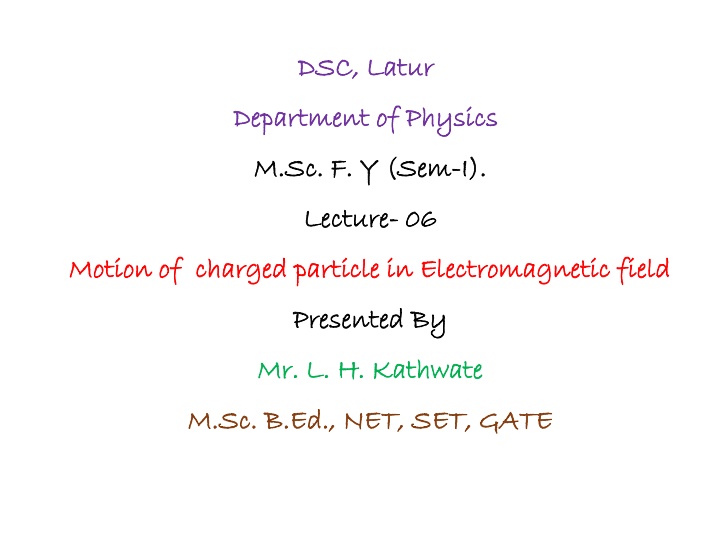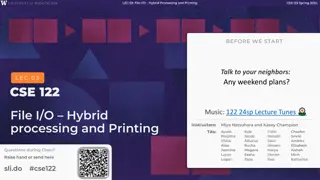
Motion of Charged Particle in Electromagnetic Fields Lecture Highlights
Explore the dynamics of charged particles in electric and magnetic fields as discussed in a physics lecture. Understand the forces acting on charged particles and how they move in various field configurations. Gain insights into the interplay of electric and magnetic fields on particle motion.
Download Presentation

Please find below an Image/Link to download the presentation.
The content on the website is provided AS IS for your information and personal use only. It may not be sold, licensed, or shared on other websites without obtaining consent from the author. If you encounter any issues during the download, it is possible that the publisher has removed the file from their server.
You are allowed to download the files provided on this website for personal or commercial use, subject to the condition that they are used lawfully. All files are the property of their respective owners.
The content on the website is provided AS IS for your information and personal use only. It may not be sold, licensed, or shared on other websites without obtaining consent from the author.
E N D
Presentation Transcript
DSC, Latur DSC, Latur Department of Physics Department of Physics M.Sc. F. Y ( M.Sc. F. Y (Sem Sem- -I). I). Lecture Lecture- - 06 06 Motion of charged particle in Electromagnetic field Motion of charged particle in Electromagnetic field Presented By Presented By Mr. L. H. Kathwate Mr. L. H. Kathwate M.Sc. B.Ed., NET, SET, GATE M.Sc. B.Ed., NET, SET, GATE
Charged particle in electric filed: According to Coulomb s law, force can be defined as; ?? ??= 4????2 ??= ?? (1) ? Where, ? = 4????2 ; Electric field on the charged particle
Charged particle in magnetic field When the velocity of a charged particle is perpendicular to a uniform magnetic field, the particle moves in a circular path in a plane perpendicular to B. The magnetic force FB acting on the charge is always directed towards the center of the circle.
Suppose that there is a magnetic field (B) perpendicular to the page and into the page. If q is charge of particle (positive) moving with velocity V as shown in figure, the magnetic force Fm on it that is normal to V making it move along a circular path. According to Lorentz law force can be defined as; ??= ? ? ? ??= ??????? (2) Here ? is angle between the velocity component and magnetic field component.
An object that is forced to go around a circular must constantly be pushed toward the center of rotation by Fc. The Fc is necessarily perpendicular to V. ??=??2 ? (3) Using equation (2) and (3) we get ??= ?? ??2 ? = ??????? ??2 ? = ??? (Since ? = 90?) ? =?? ?? ; R is the radius of circle
# Motion of charged particle in electromagnetic field: An electromagnetic field is a classical field produced by accelerating electric charges. A stationary charge will produced only electric filed in the surrounding space. If the charge is moving, a magnetic field is also produced. ??= ??+ ?? ????= ?? + ? ? ? Or ????= ?? + ??????? ???? : The force acting on particle due to electromagnetic force
Case-I: When electric field parallel to magnetic field; 1.Charge particle is at rest:
????= ?? Force on charged particle due to electric filed; ????= ??? ??=??? ? ??= ??+ ??? Where ?? is initial velocity of charged particle; in this case it is zero ??? ?? ??= ??? = Particle follows straight line trajectory.
2. Charge particle is in motion with velocity ?? in x-direction:
Force on charged particle due to electric filed; ??= ??? ??=??? ? ??= ??+ ??? Where ?? is initial velocity of charged particle; in this case it is ?? ??= ??+??? ??
Force on charged particle due to electric filed; ??= ???????? Where is the angle between velocity component and magnetic field component, in the present case ? = 0 ??= 0 Particle follows straight line trajectory:
3. Charge particle is in motion with velocity ?? in y-direction:
Force on charged particle due to electric field; ??= ??? ??=??? ? ??= ??+ ??? Where ?? is initial velocity of charged particle; in this case it is zero since particle is moving in y direction. ??? ?? ??= Particle follows straight line trajectory
Force on charged particle due to magnetic field; ??= ???????? Where is the angle between velocity component and magnetic field component, in the present case ? = 90? ??= ???? Where ?? Is a centripetal force acting on charged particle; ??= ???2 ? Radius of circle is???2 ??? ?? = ????; ? = ? Particle follows circular trajectory
Straight line (Electric Field ) + Circular path (Magnetic field = Helical path
Force on charged particle due to electric filed; ??= ??? ??=??? ? ??= ??+ ??? Where ?? is initial velocity of charged particle; in this case it is ?? ??= ?????? +??? ?? Particle follows straight line trajectory
Force on charged particle due to electric filed; ??= ???????? Where is the angle between velocity component and magnetic field component, in the present case ? 0/90? ??= ???????? Where ?? Is a centripetal force acting on charged particle ??= ???2 ? Radius of the circle is ???2 ??? ?????? = ???????? ; ? = ? Particle follows circular trajectory
Straight line (Electric Field ) + Circular path (Magnetic field = Helical path
Case-II: When electric field perpendicular to magnetic field:
Force on charged particle due to electric filed; ??= ?? (1) Force on charged particle due to electric filed; ??= ???????? Where is the angle between velocity component and magnetic field component, in the present case ? = 90? ??= ???? (2)
??= ?? charged particle follows in straight line path: ?? = ???? ??=? ?
Case-III: When electric field perpendicular to magnetic field and charge is at rest: Cycloid path of the charged particle



![Lec [2] Health promotion](/thumb/274962/lec-2-health-promotion-powerpoint-ppt-presentation.jpg)